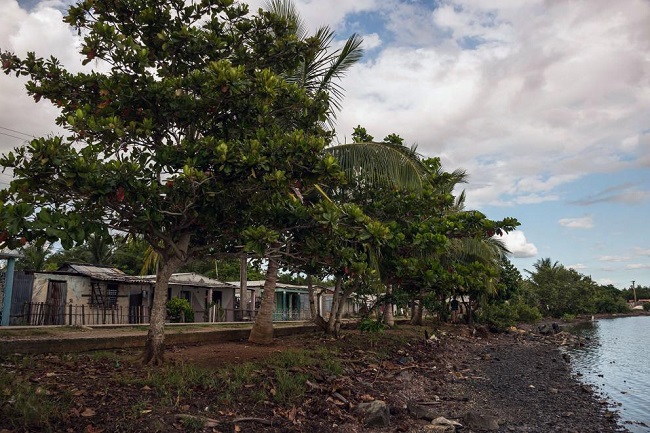In the coastal neighbourhood of Litoral in Manzanillo, Cuba, the sea is both a lifeline and a threat. Every time a storm darkens the sky, families like Martha Labrada’s brace for evacuation. And even on calm days, saltwater seeps silently into the land, corroding house foundations and tainting freshwater wells.

“The water almost always enters this area,” says Labrada, aged 65, who has led the community council here for more than a decade. “The houses were built too close to the sea, and the mangroves are deforested.”
Over the past few decades, climate-related risks along Cuba’s coastline have steadily intensified. 119 coastal human settlements have been identified as at risk from a range of climate-change-related impacts such as flooding, coastal erosion, and saline intrusion, or even disappearing altogether.
A national response aimed at restoring ecosystems and educating communities
In response to increasingly urgent climate-related threats, a quiet transformation is unfolding. With over $44 million in support from GCF and the United Nations Development Programme, the Coastal Resilience to Climate Change in Cuba through Ecosystem Based Adaptation (Mi Costa) project aims to increase the climate resilience of over 1.3 million vulnerable people living in the target coastal communities.
Spanning 24 municipalities and 7 coastal settlements, Mi Costa is a national initiative grounded in community-informed solutions, each tailored to the specific climate challenges of its location. Activities include restoring mangroves, swamp forests, and grass swamps to improve the health of seagrass beds and coral reefs, as well as partnering with communities and investing in efforts to strengthen local resilience and planning.
The project aims to train 60 per cent of the population in targeted areas to protect ecosystems, enhance climate adaptation, and respond more effectively to the impacts of climate-induced flooding.
For many, like Manzanillo fisherman Roberto David Rosales, the project’s arrival was timely. “Almost two metres were lost in this area in one year,” he says, recalling a shoreline path he once walked that has since vanished beneath the sea. “These are things that force us to be protectors of the mangroves. The Mi Costa project came at the right time.”
Restoring Cuba’s vital mangrove and wetland habitats
Mangroves and wetlands are essential parts of the global ocean system. These dynamic habitats act as natural infrastructure, reducing storm surge, anchoring soil, storing carbon, filtering water, and sheltering marine life. Protecting these systems is a step toward safeguarding the health of the ocean as a whole.
By 2029, the Mi Costa project aims to restore over 11,000 hectares of mangroves and 3,000 hectares of swamp forest. Alongside this ecological work, Mi Costa teams are building environmental monitoring systems, early warning networks, and, perhaps most importantly, trust and cooperation among local people.
In this way, Mi Costa treats coastal ecosystems as a single, living, interconnected space. The project aims to restore water flows, reforest and preserve wetlands and marsh forests, support marine areas, and engage communities whose knowledge and expertise help them adapt to their environment.
Local communities at the heart of coastal resilience
“What will make these initiatives sustainable is the ability of communities to continue them. It’s essential that people take ownership and learn to live with wetlands as facilitators of life,” says project coordinator, José Miguel Guzmán.
To date, over 10,000 people, over half of them women, have been trained through community workshops and capacity-building centres. These include lessons on hydrological monitoring, invasive species management, and gender-responsive climate action.
In the town of Cajío, Mireya Acosta knows this work is deeply personal. As a project coordinator, she’s spent hours knocking on doors, listening to neighbours’ concerns, and inviting them to be part of the solution. “My goal is to continue involving people,” she says. “This project gives the community an opportunity not only to deal with the effects of climate change but also to come together and take collective action.”
Cuba’s long-term vision for coastal ecosystem restoration
Mi Costa shows what’s possible with strong community involvement and long-term vision. The project is one of the most ambitious ecosystem-based adaptation efforts in the Caribbean, offering a model for adaptation that blends nature, science, and social mobilisation.
Though the Mi Costa project will formally run through 2029, Cuba’s government has committed to supporting its maintenance and expansion for another 22 years as a cornerstone of Cuba’s national climate strategy, Tarea Vida.
For communities on Cuba’s coastline, the work is far from over. Climate adaptation isn’t an abstract policy, it’s daily life. Mangrove nurseries are still taking shape, ditches are being dug by hand, and neighbours are learning how to protect the ecosystems that protect them. It’s hard work, but hope is growing, quietly and steadily, alongside the seedlings.
